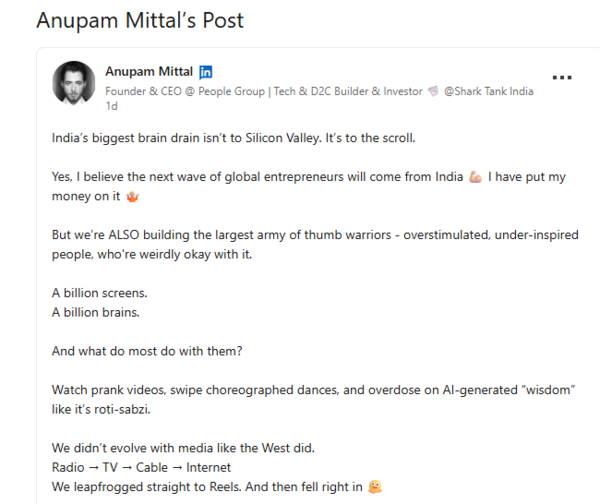India, the land that bestowed the world with “zero,” is currently raising a generation addicted to zero-attention content. As the country champions its growth in becoming the 4th largest economy, outpacing Japan, and advances in global tech and education, a silent crisis is simmering, one that does not involve immigration lines. The brain drain to Silicon Valley has always dominated the headlines. However, the present exodus is happening within. The youngsters are ecstatically bidding adieu to focus, creativity, and ambition to enter the world of social media, a realm of doomscrolling.Alas, this brain drain cannot be captured by statistics or visa quotas. It is measured through missed deadlines, shrinking attention spans, and an inability to sit through a lecture without checking social media thrice. There was a time when reading was the most preferred pastime. Now? An obsolete act. Mobile phones have substituted books, hobbies, and friendships. India’s academic engine, once synonymous with discipline and drive, is being dulled by dopamine loops fed by reels, shorts, and swipes.
A billion screens, a silent collapse
India embodies the world’s largest youth population, the stakes couldn’t be higher. Students, the cornerstone of the country, the very demographic tasked with moulding the future, are increasingly shackled by algorithms. Social media, once heralded as a tool for empowerment, has translated into a trapdoor, not just wasting time, but consuming potential.The modern menace doesn’t scream but speaks in whispers. It prevails in between study breaks, peeks through as distractions during revision. It substitutes depth with distraction, conversation with consumption, and ambition with algorithms.

Anupam Mittal’s message: A wake-up call for the youth of India
Anupam Mittal — entrepreneur, investor, and founder of Shaadi.com — has thrown has put spotlight on the existing crisis of India. In a searing LinkedIn post, the Shark Tank India judge didn’t mince words. “India’s biggest brain drain isn’t to Silicon Valley. It’s to the scroll,” he declared.Mittal’s post has effectively portrayed that India is a conducive ground for global entrepreneurs. However, it is simultaneously nurturing an army of “overstimulated, under-inspired digital addicts.”“A billion screens. A billion brains. And what do most do with them? Watch prank videos, swipe choreographed dances, and overdose on AI-generated ‘wisdom’ like it’s roti-sabzi,” he writes, reflecting on how consumption has replaced curiosity.Mittal is particularly concerned about children, including his own. “Even my 7-year-old starts with Peppa Pig and ends up in a vortex of glitchy animation and algorithmic chaos,” he shares. The evolution of media in the West, he notes, happened gradually — from radio to TV to cable to the internet. India, however, leapfrogged directly into Reels and then “fell right in.”Mittal warns of a future lacking human touch where kids don’t play, teens don’t talk, and adults don’t think- they just scroll. Their digital identity will be interwined with their existence. The danger, as he suggests, is not just distraction but the normalisation of disconnection from reality.
How doomscrolling is quietly sabotaging academic excellence
Here’s how compulsive social media use is quietly dismantling the intellectual foundation of young Indians — and why it’s time to rethink our digital diet.Cognitive overload and shattered focusSocial media platforms are engineered for dopamine hits, and garnering publicity not for deep thought. Every scroll bombards the brain with fragmented information, crippling the ability to focus on extended tasks- like reading a chapter, solving an equation, or writing an essay.Erosion of memory and comprehensionStudies have suggested that consuming bite-sized, visually over-stimulating content impacts long-term memory formation. Students may spend hours “learning” online, only to find their recall disappearing when it’s needed most — during exams or critical thinking situations.Devaluation of real learningWhen the AI-generated texts and 30-second explainers substitute the textbooks, real learning takes a backseat. This leads to shallow and superficial knowledge over gaining proficiency. Remember, in a world that is constantly being dominated by robots, the best we can do is the “be human” and strengthen our “human touch” in every way. Over time, social media will teach you to skim life and not study it.Decreased motivation and attention spanAlgorithmic content demands passivity, which gets inculcated as a trait in humans. Scrolling becomes easier than solving. We tend to look to artificial intelligence and other videos for searching the solutions, instead of delving deeper into the topic to dig out answers. With overexposure to high-stimulus content, real-world tasks such as reading, research, and revision start to feel mundane and unrewarding.Rising anxiety, falling performanceWell, social media a synonymous with the “fake world” and is leading to a more anxious generation. Paradox claps here. The platform, which was meant to be a source of entertainment, is instead fanning the flames of unhealthy competition and pressure, leading to low self-worth among students.Disconnection from critical thinkingWhen opinions are outsourced to influences and thought processes are shrunk to reaction gifs, the ability of the student to think critically and independently gets impaired. The result? A generation that can mimic but not question.Time drain masquerading as productivity“Cognitive dissonance” takes a front seat in academics. Students convince themselves that educational reels and “study motivation” content are helping them. But time audits often reveal a startling truth: Hours lost daily are cumulatively stealing months of productive learning.
A national conversation, long overdue
Anupam Mittal’s post isn’t just a viral take. It’s a rare moment of honesty from someone at the intersection of technology and parenting. His message is clear: India cannot afford to raise a generation that’s more fluent in trends than in thought.“This isn’t a call to delete social apps,” Mittal clarifies. “It’s a rant from a concerned father… and maybe a conversation about our children.”That conversation is one we can no longer postpone. Teachers, parents, policymakers, and students themselves must confront an uncomfortable truth: India’s digital gold rush may already be costing it its greatest resource, its thinking minds.
The future can’t be built on infinite scroll
But if the brightest minds remain shackled by the screens, the nation’s ascent could stall before takeoff. It is high time to recalculate the steps from consumption to chaos, distraction to discipline, and passive scrolling to purposeful learning. The future belongs to those who look up and know how to dream, not those lost in the loop and intertwined in doomscrolling. It is high time India chose its gaze wisely.













